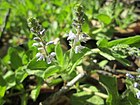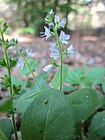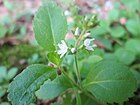Note: This is a project under development. The articles on this wiki are just being initiated and broadly incomplete. You can Help creating new pages.
Difference between revisions of "Veronica officinalis - Paul's betony"
m (Prabhakar moved page Paul's betony (Veronica officinalis) to Veronica officinalis - Paul's betony) |
|||
| Line 1: | Line 1: | ||
| − | '''Veronica officinalis''' | + | '''Veronica officinalis''' is a species of flowering plant in the plantain family Plantaginaceae. It is native to Europe and western Asia. It has been introduced to North America and is widely naturalised there. |
| − | == | + | ==Uses== |
| + | {{Uses|gout}}, {{Uses|arthritis}}, {{Uses|muscle and joint pain}}, {{Uses|loss of appetite}}, {{Uses|liver problems}}, {{Uses|skin problems}}, {{Uses|itching}}, {{Uses|heal wounds}}, {{Uses|foot perspiration}} | ||
| − | + | ==Parts Used== | |
| + | {{Parts Used|Dried Folaige}}, {{Parts Used|Whole herb}}. | ||
| − | + | ==Chemical Composition== | |
| + | Protocatechuic acid (1), luteolin (2), veronicoside (3), minecoside (4), specioside (5), amphicoside (6), catalposide (7), 6-O-cis-p-coumaroyl catalpol <ref name="chemical composition"/> | ||
| − | == | + | ==Common names== |
| + | {{Common names|kn=|ml=|sa=|ta=|te=|hi=|en=Agrimony}} | ||
| − | + | ==Properties== | |
| + | Reference: Dravya - Substance, Rasa - Taste, Guna - Qualities, Veerya - Potency, Vipaka - Post-digesion effect, Karma - Pharmacological activity, Prabhava - Therepeutics. | ||
| + | ===Dravya=== | ||
| − | + | ===Rasa=== | |
| + | Tikta (Bitter), Kashaya (Astringent) | ||
| + | ===Guna=== | ||
| + | Laghu (Light), Ruksha (Dry), Tikshna (Sharp) | ||
| + | ===Veerya=== | ||
| + | Ushna (Hot) | ||
| + | ===Vipaka=== | ||
| + | Katu (Pungent) | ||
| + | ===Karma=== | ||
| + | Kapha, Vata | ||
| + | ===Prabhava=== | ||
| − | == | + | ==Habit== |
| + | {{Habit|Herb}} | ||
| − | + | ==Identification== | |
| + | ===Leaf=== | ||
| + | {{Leaf|Simple|opposite|The leaves are lobed or unlobed but not separated into leaflets}}<ref name="Leaf"/> | ||
| − | == | + | ===Flower=== |
| + | {{Flower|Unisexual|2-4cm long|blue to purple, white|1-2|the flower is bilaterally symmetrical}} | ||
| + | |||
| + | ===Fruit=== | ||
| + | {{Fruit|general|3–4 mm|the fruit is dry and splits open when ripe|With hooked hairs|-}} | ||
| + | |||
| + | ===Other features=== | ||
| + | |||
| + | ==List of Ayurvedic medicine in which the herb is used== | ||
| + | * [[Vishatinduka Taila]] as ''root juice extract'' | ||
| + | |||
| + | ==Where to get the saplings== | ||
| + | ==Mode of Propagation== | ||
| + | {{Propagation|Seeds}}, {{Propagation|Larger divisions}}. | ||
| + | |||
| + | ==How to plant/cultivate== | ||
| + | Easily grown in a moderately fertile moisture retentive well drained soil[200]. Prefers cool summers[200]. Thrives in light shade or in open sunny positions<ref name="How to plant/cultivate"/> | ||
| + | |||
| + | ==Commonly seen growing in areas== | ||
| + | {{Commonly seen|Dry hedgebanks}}, {{Commonly seen|coppices}}, {{Commonly seen|often on dry soils}}. | ||
| + | |||
| + | ==Photo Gallery== | ||
| + | <gallery class="left" caption="" widths="140px" heights="140px"> | ||
| + | 20140511Veronica officinalis2.jpg | ||
| + | |||
| + | 20140523Veronica officinalis3.jpg | ||
| − | <references> | + | 20180506Veronica officinalis1.jpg |
| − | <ref name=" | + | |
| + | |||
| + | 20130617Ehrenpreis Schwetzinger Hardt6.jpg | ||
| + | |||
| + | 20130617Ehrenpreis Schwetzinger Hardt7.jpg | ||
| + | |||
| + | |||
| + | Veronica officinalis 1534.JPG | ||
| + | |||
| + | Veronica officinalis 1536.JPG | ||
| + | |||
| + | </gallery> | ||
| + | |||
| + | ==References== | ||
| + | |||
| + | <references> | ||
| + | <ref name="chemical composition">[https://link.springer.com/article/10.1007/s12272-009-1137-x "chemical cinstituents"]</ref> | ||
| + | |||
| + | <ref name="Leaf">[https://gobotany.newenglandwild.org/species/veronica/officinalis/ "plant Characteristics"]</ref> | ||
| + | |||
| + | <ref name="How to plant/cultivate">[https://www.pfaf.org/user/Plant.aspx?LatinName=Veronica+officinalis "Cultivation details"]</ref> | ||
</references> | </references> | ||
| − | == External Links == | + | ==External Links== |
| + | * [https://www.researchgate.net/publication/215738498_The_evaluation_of_antioxidant_potential_of_Veronica_officinalis_and_Rosmarinus_officinalis_extracts_by_monitoring_malondialdehide_and_glutathione_levels_in_rats The evaluation of antioxidant potential of Veronica officinalis] | ||
| + | * [https://www.researchgate.net/publication/281629425_Phytochemical_Characterization_of_Veronica_officinalis_L_V_teucriumL_and_V_orchidea_Crantz_from_Romania_and_Their_Antioxidant_and_Antimicrobial_Properties Phytochemical Characterization of Veronica officinalis L] | ||
| + | * [https://www.henriettes-herb.com/eclectic/kings/veronica.html Veronica officinalis on henriettes-herb.com] | ||
| − | |||
[[Category:Herbs]] | [[Category:Herbs]] | ||
Revision as of 11:27, 14 June 2018
Veronica officinalis is a species of flowering plant in the plantain family Plantaginaceae. It is native to Europe and western Asia. It has been introduced to North America and is widely naturalised there.
Contents
- 1 Uses
- 2 Parts Used
- 3 Chemical Composition
- 4 Common names
- 5 Properties
- 6 Habit
- 7 Identification
- 8 List of Ayurvedic medicine in which the herb is used
- 9 Where to get the saplings
- 10 Mode of Propagation
- 11 How to plant/cultivate
- 12 Commonly seen growing in areas
- 13 Photo Gallery
- 14 References
- 15 External Links
Uses
gout, arthritis, muscle and joint pain, loss of appetite, liver problems, skin problems, itching, heal wounds, foot perspiration
Parts Used
Chemical Composition
Protocatechuic acid (1), luteolin (2), veronicoside (3), minecoside (4), specioside (5), amphicoside (6), catalposide (7), 6-O-cis-p-coumaroyl catalpol [1]
Common names
| Language | Common name |
|---|---|
| Kannada | |
| Hindi | |
| Malayalam | |
| Tamil | |
| Telugu | |
| Marathi | NA |
| Gujarathi | NA |
| Punjabi | NA |
| Kashmiri | NA |
| Sanskrit | |
| English | Agrimony |
Properties
Reference: Dravya - Substance, Rasa - Taste, Guna - Qualities, Veerya - Potency, Vipaka - Post-digesion effect, Karma - Pharmacological activity, Prabhava - Therepeutics.
Dravya
Rasa
Tikta (Bitter), Kashaya (Astringent)
Guna
Laghu (Light), Ruksha (Dry), Tikshna (Sharp)
Veerya
Ushna (Hot)
Vipaka
Katu (Pungent)
Karma
Kapha, Vata
Prabhava
Habit
Identification
Leaf
| Kind | Shape | Feature |
|---|---|---|
| Simple | opposite | The leaves are lobed or unlobed but not separated into leaflets |
Flower
| Type | Size | Color and composition | Stamen | More information |
|---|---|---|---|---|
| Unisexual | 2-4cm long | blue to purple, white | 1-2 | the flower is bilaterally symmetrical |
Fruit
| Type | Size | Mass | Appearance | Seeds | More information |
|---|---|---|---|---|---|
| general | 3–4 mm | the fruit is dry and splits open when ripe | With hooked hairs | - | {{{6}}} |
Other features
List of Ayurvedic medicine in which the herb is used
- Vishatinduka Taila as root juice extract
Where to get the saplings
Mode of Propagation
How to plant/cultivate
Easily grown in a moderately fertile moisture retentive well drained soil[200]. Prefers cool summers[200]. Thrives in light shade or in open sunny positions[3]
Commonly seen growing in areas
Dry hedgebanks, coppices, often on dry soils.
Photo Gallery
References
External Links
- Ayurvedic Herbs known to be helpful to treat gout
- Ayurvedic Herbs known to be helpful to treat arthritis
- Ayurvedic Herbs known to be helpful to treat muscle and joint pain
- Ayurvedic Herbs known to be helpful to treat loss of appetite
- Ayurvedic Herbs known to be helpful to treat liver problems
- Ayurvedic Herbs known to be helpful to treat skin problems
- Ayurvedic Herbs known to be helpful to treat itching
- Ayurvedic Herbs known to be helpful to treat heal wounds
- Ayurvedic Herbs known to be helpful to treat foot perspiration
- Herbs with Dried Folaige used in medicine
- Herbs with Whole herb used in medicine
- Herbs with common name in English
- Habit - Herb
- Index of Plants which can be propagated by Seeds
- Index of Plants which can be propagated by Larger divisions
- Herbs that are commonly seen in the region of Dry hedgebanks
- Herbs that are commonly seen in the region of coppices
- Herbs that are commonly seen in the region of often on dry soils
- Herbs






